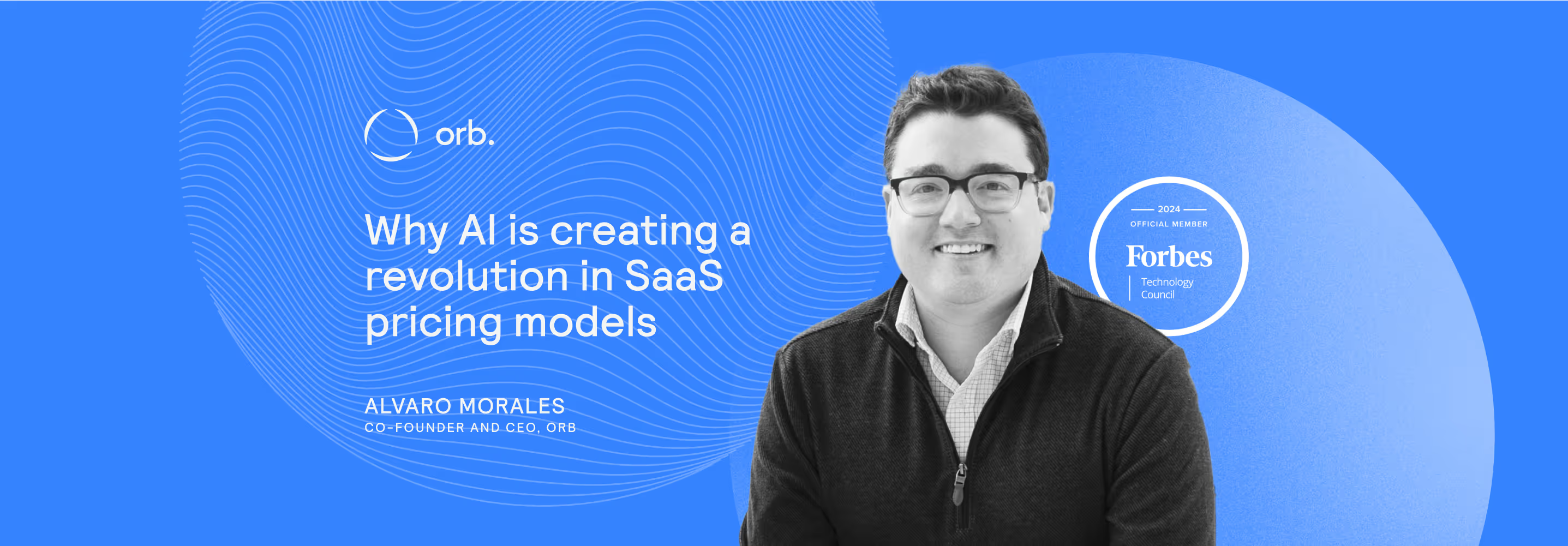
Forbes Tech Council: Why AI Is Creating A Revolution In SaaS Pricing Models
This article was originally posted on Forbes as part of their Forbes Technology Council series.
Many SaaS companies want to leverage AI in their products. However, since AI is so new, pricing remains volatile. Costs can drop drastically for an AI model when the next iteration is out, and many companies lower their pricing in response to a competitor launch to gain or retain market share.
In addition to the fluctuating and unpredictable model prices, AI pricing is mostly based on usage. Customer usage is usually difficult to predict, which affects the costs your product will incur if it relies on AI models.
The unpredictability of usage and model changes means that today’s common seat-based or fixed pricing will likely not remain sustainable. Additionally, thanks to AI's increased productivity, a few people can achieve what previously took dozens. The very reason AI is so powerful is counterproductive to seat-based pricing.
As businesses continue to optimize their teams and processes with AI, they reduce the number of users needed to operate. The seat-based model can limit your revenue as your product gets more efficient.
Common SaaS Pricing Structures Today
To understand how to address these concerns, let's look at the different pricing models available.
As mentioned above, one standard pricing structure for SaaS products today is seat-based. That is, you pay based on the number of users. This was the pricing model when I worked as an engineering leader at a major SaaS company, where we spent six months deciding how to raise our per-seat pricing by $1.
Seat-based pricing, as I explained, isn’t compatible with AI because you won’t be able to predict individual customer usage of AI models and features. Also, customers won’t need as many seats if AI features make users more efficient.
SaaS companies can also offer flat-rate pricing, which is where you offer one standard price regardless of the number of users or volume of usage. This only works if your product has few variables, particularly ones that affect your cost of operations.
Tiered pricing has flat rates based on groupings, usually dependent on usage ranges or feature access. This pricing structure considers more usage and different feature options, allowing you to set a higher price to access your AI features. Although a good choice, it relies on your customers to accurately predict how much they will use AI features when choosing their tier.
One way to make a tiered pricing structure work with AI is to make it easy for customers to switch between tiers. At the same time, it’s a delicate balance to incentivize users on higher tiers to remain there while still ensuring they get maximum value with your product.
Because of the concerns, a usage-based pricing structure with a prepaid credit (PPC) might best accommodate AI changes and fluctuating customer usage while providing maximum value. Prepaid credits can offer customers more control and predictability over their spending—especially for enterprise users.
Switching Your Pricing Model
Today, 77% of consumers use AI—whether they know it or not. There is no doubt that AI is the future of SaaS.
AI is both necessary and a wild card regarding usage and cost. Because of this, AI will change the optimal way companies charge customers—it is up to companies how much pain they want to experience beforehand.
This is why it will be important to change your pricing structure swiftly and thoroughly rather than dragging out the process. Ultimately, a half-hearted pricing update will result in death by a thousand cuts. Determining to make no changes and see what happens can result in expenses quickly outpacing revenue.
Your pricing will continue evolving, so it may be helpful to keep pricing coded outside your product. As your product improves, it can be tempting to connect much of your pricing logic to actions within the product or the number of users.
However, this sets you up for failure. If you need to change one aspect of pricing, you risk breaking connections you didn’t even know existed, ruining customers' product experience and losing their trust.
For those excited about AI, the prepaid credits model can help program your pricing logic to your custom credits. This system helps keep your pricing flexible, so if you need to change and adjust, you can do so quickly and without interruption.
This will be usage-based and, more importantly, value-based.
How To Prepare For Usage-Based Pricing
Now, that I’ve covered the need for a dynamic pricing model, let’s talk about how to implement it. If you’re looking to switch to a usage-based, prepaid credits model, for example:
1. Inventory all the services and features you provide customers today. Avoid making assumptions about what users will and won’t be willing to pay for at this stage.
2. Once you have a list of everything your tool does, assign an internal monetary value for that service. What does it cost you to provide and support those features? For example, any AI features have real costs associated when you make calls to an AI model.
3. From there, work with your finance team to determine how much you should charge based on usage and feature access and translate that monetary amount to how many credits you should charge for the service.
4. Next, you need to build out your product and billing system. Your customers must be able to purchase credits and have them added to their accounts. Your product must function solely on those credits as internal currency.
By doing this, you ensure any pricing changes you make only need to affect how you charge for credits rather than how credits are used within your product.
Using A Future-Proof Pricing Engine
SaaS companies are no strangers to evolution. Pivots are second nature and often necessary for success. Consider your pricing a lever for growth in an AI-powered ecosystem. Be smart about your pricing structure and strategic with how you route pricing logic, and you’ll be able to adapt and stay flexible as AI continues to evolve and improve your product and customer experience.
Ready to solve billing?





